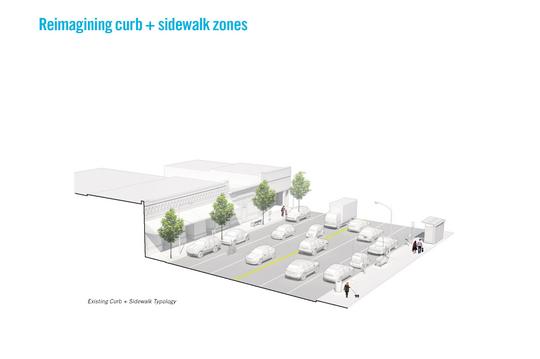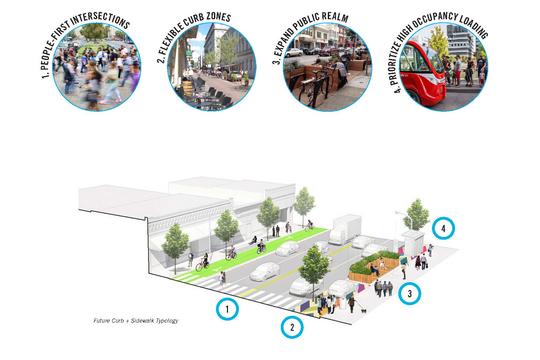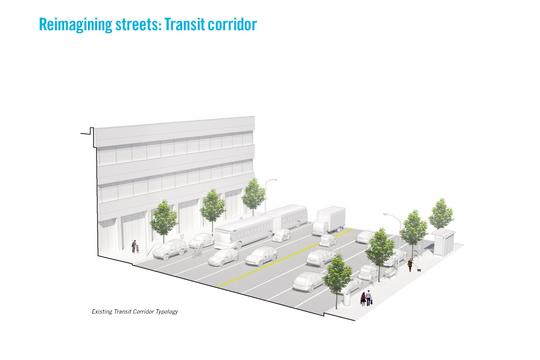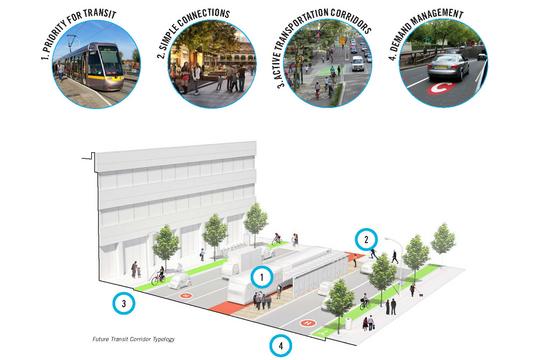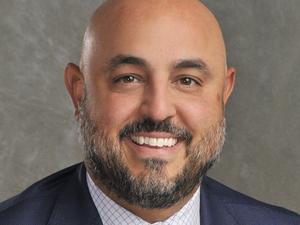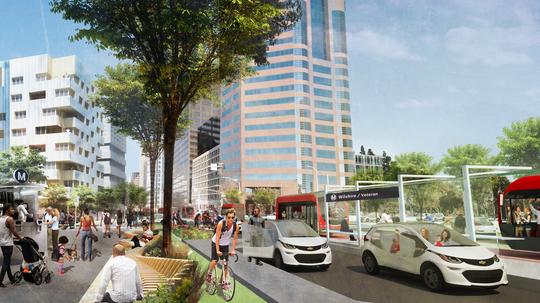
Editor's Note: This story has been edited to reflect the State of Georgia approved The Ray to install a 1-megawatt solar array by an exit ramp outside of LaGrange.
America’s transportation infrastructure needs help—lots of it.
Last year, the American Society of Civil Engineers gave America’s infrastructure a D+ in its comprehensive report compiled every four years. In 2014, Georgia’s transportation infrastructure scored a C. For a state that is now home to the country’s third-fastest growing metro area, this is unacceptable—especially considering the city is in need of transportation infrastructure updates valued at roughly $900 million, a figure that could rise to $1.5 billion if left unchecked for much longer.
Atlanta is expected to be the 6th largest metro area in the country by the 2040s, and it remains a contender for Amazon’s highly-coveted HQ2 bringing an estimated 50,000 new jobs along with it, assuming Atlanta’s transportation infrastructure challenges don’t scare the tech giant away.
It’s no secret that Atlanta’s transportation infrastructure is an urgent and expensive problem, but for those who had their hopes up that the federal government might offer a helping hand, it’s looking more and more likely that this won’t be happening anytime soon. Congress has only approved about 1 percent of the current administration’s proposed $1.5 trillion in infrastructure spending, hesitant to add more to the country’s looming debt.
In the largest infrastructure investment for the city in over a decade, the City of Atlanta is committing $250 million to tackle the issue (paid for by the Renew Atlanta bond), but even this—coupled with the $300 million TSPLOST hopes to raise in its new four-tenths of a penny sales tax increase—won’t cover the full $900 million needed to bring Atlanta’s roads up to standards.
While understanding that roads make up a significant majority of the current transportation infrastructure in metro Atlanta, it is important to note that rail, transit-priority lanes, sidewalks and bike lanes will all be vital to accommodating population and trip growth without compounding existing vehicular traffic woes in the region. To solve its looming transportation problems, the City of Atlanta will need to better balance creativity and cost-efficiency by embracing innovative transportation infrastructure plans, products and processes.
- Innovation in motion
Thanks to a forward-thinking municipal government, the City of Atlanta is already taking small steps to explore innovative solutions.
The North Avenue Smart Corridor made headlines last year when it was announced that the central traffic corridor connecting Ponce City Market, Georgia Tech and the Coca Cola headquarters would begin work on its first phase in summer 2017. The smart corridor is an award-winning effort to improve the livability, safety and sustainability of a busy road in Midtown, putting the city’s people (not its cars) at the forefront of the redesign.
In partnership with Georgia Tech, the City of Atlanta collects traffic data from various different network-connected devices to aid in maximizing traffic flow for cars, pedestrians and cyclists, resulting in fewer carbon emissions, less wear and tear for the road and improved safety and accessibility for pedestrians and cyclists.
It’s exciting that the city is taking this action, but it shouldn’t stop with North Avenue. There are myriad other busy roads around town that could benefit from thermal sensor-enabled crosswalks that detect pedestrians and warn oncoming traffic and cameras that implement artificial intelligence to “tell” other traffic lights when to change.
The City of Atlanta’s new partnership with Georgia Tech holds serious potential for data-based decision making that will do wonders for the city’s livability and ability to compete internationally. We would be remiss in not making the most of such a unique opportunity.
- Opportunities to employ new solutions
Atlanta’s municipal government seems to be in the right headspace in terms of building modern roads, but why stop there? Why can’t we be looking to build the roads of the future, as cities such as Copenhagen, Vancouver and Barcelona are doing now?
Earlier this year, the architecture and design firm Perkins+Will published a report titled “Designing for Future Mobility: Developing a Framework for the Livable Future City.” This report is a comprehensive look at the livable city of tomorrow and features a case study performed in partnership between Perkins+Will, Nelson\Nygaard and Lyft on an imagined redesign of Wilshire Boulevard, a traffic-dense corridor in downtown Los Angeles.
One critical take-away from the Wilshire Boulevard study was the notion that re-programming existing right-of-way to prioritize the modes (high-occupancy, high-quality transit/walking/biking) that move people more efficiently and result in lower carbon emissions is fundamental to supporting more livable cities and reducing congestion.
With Atlanta working overtime to give Los Angeles a run for its money on traffic, many of the same solutions proposed in the report may also work well for Atlanta. Expanding sidewalks to improve pedestrian safety, adding bike lanes with buffers and encouraging the shift to more efficient, traditional modes of transport could offer real benefits in terms of improving Atlanta’s livability, reducing the overall cost of road maintenance, and curbing greenhouse gas emissions.
When it comes to road surfaces themselves, there is tremendous inertia preventing adoption of innovative road construction products and processes. Unfortunately, in Georgia (and in numerous other states around the country), contractors are using many of the same construction methods and materials that have been around since the 1970s, while newer, less expensive and sturdier methods and resources are available today.
For example, Tensar – an Atlanta-based company – invented the Geogrid over 40 years ago. Geogrid is a plastic mesh with triangle shaped apertures that goes under roads to keep them stable and smooth – reducing cost of installation and repair. The company introduced its Triax Geogrid in 2007, which offers major improvements over previous Geogrid designs in terms of the time and cost needed to build roads in addition to reducing the incidence of potholes and ruts that cost thousands of dollars in damage per Atlanta driver each year.
In building the city of the future, we should be building with the future in mind and investing in updated construction processes and infrastructure inputs that will save the city money in both the short and long term.
Bringing Atlanta’s transportation infrastructure up to speed will certainly involve redesigning existing roads and building new ones more efficiently and effectively. However, simply adding more or wider roads won’t sufficiently address growing Atlanta’s transportation needs.
Transportation research and experience suggests, overwhelmingly, that widening roadways is an ineffective and even counter-productive approach to meeting transportation needs. Increased capacity consistently induces additional demand, resulting in no net benefit for travel time or congestion while sinking limited resources into modes that run counter to livable city goals such as reducing emissions, improving health and well-being and promoting more sustainable settlement patterns.
Gallery
- Obstacles
Innovation is undoubtedly the path forward, but it doesn’t come without risks. Many departments of transportation and innovation offices around the country are interested in creative solutions to combat transportation infrastructure issues, but they’re also hesitant to take risks on plans that haven’t been road-tested.
The City of Atlanta may not be to the point where it’s investing in solar road panels, but you don’t have to only focus on high-tech solutions to see the way a small stretch of I-85 in southwestern Georgia is proving skeptics wrong about smart and sustainable roadways.
The Ray is a living example of how roads can be built successfully with sustainable, forward-thinking goals in mind. This 18-mile stretch between West Point and LaGrange does indeed generate electricity through solar road panels (the Wattway) designed by French transportation company Colas, but it also helps reduce road runoff pollution from harmful substances such as rubber, lead and oil through the addition of bioswales, and will one day make use of embedded roadway light studs to warn drivers of traffic or accidents ahead, other cars hiding in blind spots and more.
The Ray’s president, Harriet Anderson Langford, hopes all these technologies will make for a “carbon-free highway…[meaning] zero waste, zero carbon, zero deaths.” The road is proving to be a valuable test lab for new technologies, roadway designs and sustainable practices.
The State of Georgia just approved The Ray to install a 1-megawatt solar array by an exit ramp outside of LaGrange as a way to generate electricity for the local power grid. All this comes at a cost, but backers of The Ray (which include the Ray C. Anderson Foundation, government agencies and various companies) expect the road to actually generate revenue, whereas no revenue is directly generated by traditional asphalt roads.
While infrastructure innovation certainly can be costly, we’re unfortunately now learning the hard way that not investing in innovation is even more expensive in the long run. A $900 million infrastructure backlog may seem insurmountable, but the City of Atlanta is steadily chipping away at the necessary updates, work that wouldn’t have been possible without taking the last eight years to increase the city’s cash reserves from $7.4 million to $200 million and to boost the city’s credit rating to AA+.
Atlanta will hopefully take necessary steps to address the infrastructure backlog before it hits the estimated $1.5 billion mark, but that will only happen if we push to make infrastructure a priority, not in a few years, but now.
- Infrastructure is Destiny
One of the arguments often heard against innovation or even investing in improving transit and active transportation is the belief among some that this money would be “wasted” because autonomous cars are just on the horizon and will solve our transportation problems.
Research suggests, however, that investment in an infrastructural framework that prioritizes transit, biking, walking and land use patterns that reduce trip demand is essential if we have any hope of making our cities more livable as we move into an increasingly---albeit incrementally so---automated future.
Consider the way we re-designed our cities starting in the 1920s around another revolutionary, new transportation technology of its time---the automobile. The cities we’ve inherited today are the result of planning and investment decisions made in the past that defined how we move and live today.
As co-founder and former CEO of Zipcar, Robin Chase, likes to say, “Infrastructure is destiny.” Doubling down on a framework that puts single-occupant vehicles first (autonomous or not) will push us further down the road of automobile dependence and the consequences we are already struggling to solve. Re-shaping our infrastructure to prioritize moving people, promote low-carbon mobility and foster social cohesion will allow us to integrate new technologies to support those goals instead of letting technology dictate those decisions.
Talk about transportation infrastructure isn’t always thrilling, but if Atlanta is going to be prepared to take its place among the most populous cities in the country and to, frankly, stand a chance in a more globally competitive world, it’s a talk that must be had.
Amazon isn’t the only company that may begin to balk at our transportation dysfunction. We know we can’t put off investing in innovative solutions to our mobility infrastructure problem any longer. We have the backbone of a vibrant walking and biking network, data-based roadway designs, the technology to make them a success and an incredible innovation resource in Georgia Tech, to name a few current advantages—the city should strike now while the iron of infrastructure innovation is hot.
A tremendous opportunity to become a global leader in building the city of the future awaits Atlanta, and it’s time the city steps up to the plate to accept this challenge.
